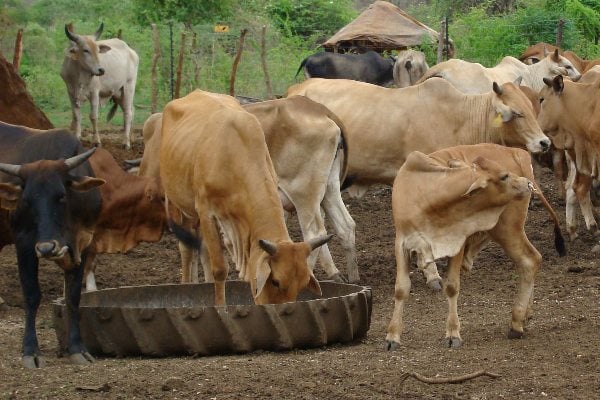Dr . Dave Midgley, stock health expert and farmer, shares inventive, practical ideas for designing feeding troughs, which he has seen over many years of visiting farms.
It’s not only what you feed animals that are important when it comes to livestock production, but also how you feed them. Dung soiled feeding and water troughs can lead to reduced feed intake and cause disease or conditions such as coccidiosis.
Midgley explains that this is a parasitic disease of the intestinal tract of animals. It spreads from one animal to another by contact with infected faeces or the ingestion of infected tissue. Coccidia are microscopic, spore-forming, single-celled parasites.
Midgley suggests that farmers keep cleaning equipment, such as a broom, on their vehicle or when visiting animals so they can clean feed troughs regularly. When you’re driving around on the farm and see a dirty trough, you can easily sweep it quickly. He says it’s also important to raise troughs off the ground to prevent wastage or animals from trampling and defecating in them.
But feeding troughs don’t have to cost a fortune to be efficient. An inexpensive pipe, an old tyre, drum or canister can make the best concentrate-feeding trough for small stock. Here are some examples:
Discarded tyres can be used in many ways to make feed troughs. Construct a tripod using poles: secure three rods with a bolt at the top. Place the tripod around the tyre.
Construct a smaller triangle by welding three pieces of metal together. Insert the triangle between the tripod legs, below the tyre, to balance it.
The benefit of rubber troughs is that there are no sharp edges that can injure animals during feeding. The tripod is compact and can also be moved between paddocks as needed.

An empty storage drum makes a practical feeding trough that keeps feed spoilage to the minimum.
Place the drum on the ground horizontally and use a grinder to cut open a section in the centre of the top. Lift the loose end outwards to create a slight overhang.
Positioned correctly, the overhang will protect the feed from the sun, rain, dust, wind and snow. Mount the drum on droppers.
Midgley suggests that farmers cut a hosepipe lengthways and secure it onto the sharp edges of the drum to protect sheep from injuries.

This farmer constructed a feeding trough with a platform on which goats can stand and feed in the way they prefer. Any metal (eg hard iron or steel) can be used to construct this feed trough, but remember that steel is expensive.
The platform should be big enough so that the goats can stand on it comfortably.

Mtata farmer, Livingston Fukile, designed this feeding trough using PVC pipes.
He joined them to form a long trough and fastened them to the fence of the pen/kraal. He raised this trough from the ground by placing it on large bricks.
Farmers could also attach plastic canisters (cut off the top section) to the outside of the pen. Midgley says this trough is a good idea, even in kraals. The animals feed from inside, so they can’t get into the troughs.

Old stainless steel irrigation pipes were used to make this trough.
Use a grinder to remove the top third and fasten droppers on each side of the bottom two-thirds to raise the structure off the ground.
The pipe opening is just big enough for sheep to get to the feed. Line the sharp edges with protective rubber. This is a good idea if you farm goats, as goats are browsers and often feed with their heads facing upwards.

Turn an old tyre inside out (there’s a special machine that can do this) and place a rubber mat, a piece of wood or a metal sheet in the bottom to stop the food from falling out.
Midgley says the only drawback of using a single tyre is that sheep can get into it. Farmers often place one tyre on top of another to stop sheep from climbing inside and treading soil, dust and faeces into the feed. These raised troughs could be too high, however, for lambs and smaller animals to reach the feed.





